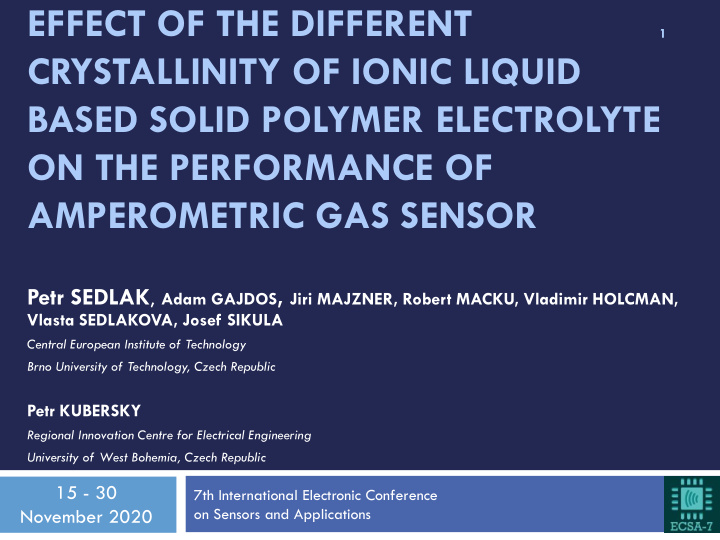



EFFECT OF THE DIFFERENT 1 CRYSTALLINITY OF IONIC LIQUID BASED SOLID POLYMER ELECTROLYTE ON THE PERFORMANCE OF AMPEROMETRIC GAS SENSOR Petr SEDLAK , Adam GAJDOS , Jiri MAJZNER, Robert MACKU, Vladimir HOLCMAN, Vlasta SEDLAKOVA, Josef SIKULA Central European Institute of Technology Brno University of Technology, Czech Republic Petr KUBERSKY Regional Innovation Centre for Electrical Engineering University of West Bohemia, Czech Republic 15 - 30 7th International Electronic Conference November 2020 on Sensors and Applications
Motivation 2 INTRODUCTION Amperometric sensing principle measurement of the current flow produced by an oxidation-reduction reaction, After voltage between WE and CE across electrolyte is applied, WE reacting with gas generates a current flow as a function of concentration. Sensitivity connected to WE material the morphology of the electrochemical active interface SPE/WE ? performance of crystallinity of amperometric solid polymer sensor electrolyte
Sensors layout and fabrication 3 EXPERIMENTAL Fabrication steps: Preparation of platinum pseudo- reference electrode and the counter electrode on alumina substrate, SPE layer deposited by drop casting technique, place substrate on a hot plate and kept the sampe a at an Solid polymer electrolyte (SPE) consists of appropriate temperature for a (i) ionic liquid [BMPYR][N(Tf)2], specific time, (ii) Polymer matrix poly(vinylidene fluoride), and deposit working electrode by (iii) solvent 1-methyl-2-pyrrolidone. airbrushing of spherical glassy carbon powder. Kuberský, P.; Syrový , T.; Hamáček , A.; Nešpůrek , S.; Syrová , L. Towards a fully printed electrochemical NO2 sensor on a flexible substrate using ionic liquid based polymer electrolyte. Sensors Actuators B Chem. 2015, 209, 1084 – 1090
Experimental set-up 4 EXPERIMENTAL Noise measurement setup particular sensor – a part of potentiostat circuit, battery as power sources, V RE = 0.5 V, sampling frequency 10 kHz and load resistance RL= 1 M Ω Experimental setup PTFE testing chamber, two gas tanks [AIR + 100 ppm NO2, AIR], T = 298 K, RH = 40%, analyte flow rate = 1 L/min . Sedlák, P.; Kuberský, P.; Mívalt, F. Effect of various flow rate on current fluctuations of amperometric gas sensors. Sensors Actuators, B Chem. 2019 , 283 , 321 – 328. Sedlák, P.; Kuberský, P. The Effect of the Orientation Towards Analyte Flow on Electrochemical Sensor Performance and Current Fluctuations. Sensors 2020 , 20 , 1038.
SPE morphology 5 RESULTS and DISCUSSION The surface of SPE consists of very small spherical SPE objects whose diameter increases with crystallization temperature, thus the lower value of this temperature results in higher porosity of prepared SPE. diameters <4.94 ± 0.64 > μ m <3.64 ± 0.37 > μ m <3.04 ± 0.19 > μ m 120 ° C 1.5 min 120 ° C 3.5 min 160 ° C 10 min 90 ° C 1.5 min Sedlak, P.; Gajdos, A.; Macku, R.; Majzner, J.; Sedlakova, V.; Holcman , V.; Kuberský, P. The effect of thermal treatment on ac/dc conductivity and current fluctuations of PVDF/NMP/ [EMIM][TFSI] solid polymer electrolyte. Submitted to Scientific Reports
WE/SPE morphology 6 RESULTS and DISCUSSION
Sensor DC response 7 RESULTS and DISCUSSION - The ionic conductivity of SPEs increases with increasing solvent evaporation temperature. - As concentration increases, the DC component linearly increases for all orientations. - The highest DC response corresponds to the SPE of the highest temperature and the longest interval of treatment after deposition. Figure dependences of DC current on NO2 concentrations . Sedlak, P.; Gajdos, A.; Macku, R.; Majzner, J.; Sedlakova, V.; Holcman , V.; Kuberský, P. The effect of thermal treatment on ac/dc conductivity and current fluctuations of PVDF/NMP/ [EMIM][TFSI] solid polymer electrolyte. Submitted to Scientific Reports
Current fluctuations 8 RESULTS and DISCUSSION At zero concentration • thermal noise, f -1.25 noise component indicates diffusion-dominant • electrode electrolyte interface, or f -2.00 noise component indicates drift-dominant • electrode electrolyte interface. At higher NO 2 concentration • noise component of Lorentzian-a-like spectra given by analyte flow around sensor, • thermal noise, f -2.00 noise component indicates drift-dominant • electrode electrolyte interface. Figure Spectral densities of current fluctuations depending on NO 2 concentrations with SPE prepared at conditions ( a ) 90 ° C 1.5 min,, ( d ) 160 ° C 10min.
Results and discussion 9 RESULTS and DISCUSSION The sensor with the SPE of the highest temperature and the longest interval of treatment after deposition exhibits • the highest current fluctuations in the frequency range, • the highest level of noise background level. Figure Spectral densities of current fluctuations depending on NO 2 concentrations for the frequency range from 0.1 Hz up to 100 Hz for the sensors with SPE prepared at conditions ( a ) 90 ° C 1.5 min, ( b ) 120 ° C 1.5min, ( c ) 120 ° C 3.5 min, ( d ) 160 ° C 10min.
Limit of detection 10 RESULTS and DISCUSSION The limit of detection (LOD) is introduced as the ratio of the triple standard deviation of the background current noise (at zero concentration) and sensitivity (dc current pre ppm). The sensor of the highest DC response (sensitivity) exhibit the worst LOD value. Fig. Limit of detection for four sensors of different SPE processed by different treatment conditions.
Conclusions 11 SPE of different crystallinity affects the performance of amperometric gas sensor from the point of view current response (sensitivity), limit of detection, and current fluctuations. The morphology of SPE has impact not only on its conductivity but also on sensor sensitivity due to morphology of the interface WE/SPE.
thank you for your attention questions ?? 12
Recommend
More recommend